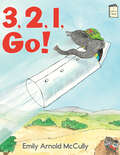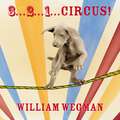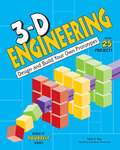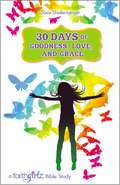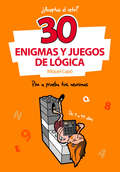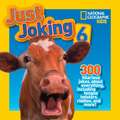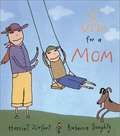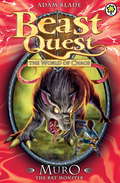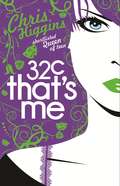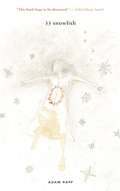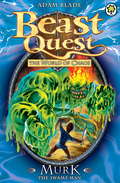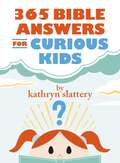- Table View
- List View
3, 2, 1 … Bungee! The Science Behind the Jump (Fountas & Pinnell Classroom, Guided Reading)
by Claire GoldingNIMAC-sourced textbook. It's Scary Up There … A high bridge. A deep gorge. A long fall. It might sound like a recipe for disaster—but thanks to science it's just a thrilling way to spend an afternoon.
3, 2, 1, Go! (I Like to Read)
by Emily Arnold McCullyFly into fun with a determined girl engineer named Min who finds a clever way to join her big sister's games. This Level G book is perfect for young readers building their vocabulary and skills! Big Sister Ann and her friend Bess are playing school—and Min wants to join in. But Ann tells Min she's not ready for school. "Here is the line." says Ann, "You may not step over it." Min doesn't give up so easily, though—she finds a rock and a board, some rope and a tube, and builds herself a catapult and rocket. Launching herself into the air and over the line, Min ends up in the middle of the playdate without stepping over the line. Beginning readers will cheer underdog Min's triumphant landing in this easy-to-read book that celebrates ingenuity and perseverance. Detailed watercolor illustrations by Caldecott medalist Emily Arnold McCully showcase the budding engineer's brilliant plan. They'll all play rocket scientists instead! The award-winning I Like to Read® series focuses on guided reading levels A through G, based upon Fountas and Pinnell standards. Acclaimed author-illustrators--including winners of Caldecott, Theodor Seuss Geisel, and Coretta Scott King honors—create original, high quality illustrations that support comprehension of simple text and are fun for kids to read with parents, teachers, or on their own! For early-to-mid first grade readers, Level G books feature more complex storylines than prior levels, and a wider variety of structure and punctuation. Illustrations offer support for decoding the more challenging vocabulary words introduced.
3, 2, 1... ¡Acción! (¡Reporteros! #Volumen 1)
by Luigi GarlandoTomi, el líder de los Cebolletas, y sus amigos se embarcan en una nueva aventura: la creación de un periódico de barrio. ¡Ha nacido un nuevo periódico! Tomi y sus amigos están eufóricos: ¡van a convertirse en periodistas de verdad! El director de la redacción, Tino, ya lo ha decidido: Tomi estará al cargo de la sección de deportes, Nico se ocupará de la actualidad y Eva, de las páginas de sociedad. Pocos días después de la inauguración, la redacción ya saca humo. ¡Hay mil y una cosas que hacer!
3-2-1 Circus!
by William WegmanA kid-friendly concept book about countingWhat could be more irresistible than puppies? Puppies at the circus! William Wegman combines his signature Weimaraner photographs with colorful drawings to create a carnival of cute pups. Of course, counting by puppy clowns, acrobats, and trapeze artists makes learning numbers in 3…2…1…Circus! a whole lot more exciting.Read this board book alongside William Wegman’s Early Rider for an entertaining and educational puppy pairing.
3-D Engineering
by Vicki V. MayHow did somebody come up with the idea for bridges, skyscrapers, helicopters, and nightlights? How did people figure out how to build them? In 3D Engineering: Design and Build Your Own Prototypes, young readers tackle real-life engineering problems by figuring out real-life solutions. Kids apply science and math skills to create prototypes for bridges, instruments, alarms, and more. Prototypes are preliminary models used by engineers--and kids--to evaluate ideas and to better understand how things work. Engineering design starts with an idea. How do we get to the other side of the river? How do we travel long distances in short times? Using a structured engineering design process, kids learn how to brainstorm, build a prototype, test a prototype, evaluate, and re-design. Projects include designing a cardboard chair to understand the stiffness of structural systems and designing and building a set of pan pipes to experiment with pitch and volume. Creating prototypes is a key step in the engineering design process and prototyping early in the design process generally results in better processes and products. 3D Engineering gives kids a chance to figure out many different prototypes, empowering them to discover the mechanics of the world we know.
30 Days of Goodness, Love, and Grace: A Faithgirlz Bible Study
by ZondervanThis insightful 30-day eBook Bible study contains selections from the Faithgirlz Secret Power Girls Bible Study series. Written especially for fun-loving girls ages 8-12 by beloved author Susie Shellenberger, the deep truths found in each day will challenge, inspire, and nourish your growing soul. Includes selections from The Secret Power of Love (book of Ruth), The Secret Power of Grace (1 Peter), and The Secret Power of Goodness (Colossians). The Secret Power of Love: Like Cinderella, sometimes it’s easy to feel left out and ignored. Maybe things with your family aren’t right, or you don’t feel very lovable. But something amazing happens when you discover God’s love. Journey through the book of Ruth and study one girl’s real-life “Cinderella story,” and see how God transformed her world. The Secret Power of Grace: You probably want to achieve great things. You probably want a happy life. And you probably want to look incredible every step of the way, sporting a style that makes you sparkle. For a girl like you, that’s no problem—because you’re about to discover the secrets to true success, lasting joy, and a killer style you’ll never outgrow. Cruise through the book of 1 Peter and learn God’s ideas about a beauty and style unlike anything money can buy at the mall. The Secret Power of Goodness: Sometimes it seems everyone has a different idea of what is true. Some people say that truth is simply whatever works for you. But what if you found reliable truth—as solid and real as the ground you walk on? What if it changed your life? What if it changed you? Come explore the book of Colossians and learn to sort through what you hear about other’s beliefs while discovering what makes our faith special and what it means to be a Christian.
30 Days of No Gossip
by Stephanie FarisCan a middle school gossip queen change her ways, or will she lose her BFF for good? Find out in this M!X original novel.Maddie Evans prides herself on being the gossip queen of Troy Middle School. She is the first person her classmates go to when they need the latest news on the ins-and-outs of TMS--and Maddie never disappoints. Her best friend since birth, Vi, isn't crazy about Maddie's penchant for passing on rumors, but it's never been an issue in their friendship. Until the day Maddie lets slip who Vi is crushing on--in front of her crush. Vi is furious, and she confronts Maddie with an ultimatum: no gossip for 30 days, or twelve years of sisterhood goes down the drain. Maddie agrees, but only a week into the challenge, she gets one of the juiciest pieces of gossip EVER--something that could affect the future of the school. Will she be able to keep her mouth shut and tame her ways? Or will she be left standing alone with no one to hear her stories?
30 Days to Getting over the Dork You Used to Call Your Boyfriend
by Clea HantmanBEING DUMPED HURTS. But you know what? It happens to everyone. Even Gwyneth, even Cameron, even Madonna have been on the losing end of love. The part you might not believe is that no matter how brutally your heart’s been broken, those wounds will heal. But the longer you dwell on the dork, the longer your heart will remain cracked. Enter 30 Days to Getting Over the Dork You Used to Call Your Boyfriend. One day at a time, 30 days in a row. At the end, you’ll find you have the power to yank that dagger out of your chest, stand tall, walk proud, and move on. And along the way, you may just discover something marvelous and surprising about yourself. From the Trade Paperback edition.
30 Days to Getting over the Dork You Used to Call Your Boyfriend
by Clea HantmanBEING DUMPED HURTS. But you know what? It happens to everyone. Even Gwyneth, even Cameron, even Madonna have been on the losing end of love. The part you might not believe is that no matter how brutally your heart's been broken, those wounds will heal. But the longer you dwell on the dork, the longer your heart will remain cracked. Enter 30 Days to Getting Over the Dork You Used to Call Your Boyfriend. One day at a time, 30 days in a row. At the end, you'll find you have the power to yank that dagger out of your chest, stand tall, walk proud, and move on. And along the way, you may just discover something marvelous and surprising about yourself.From the Trade Paperback edition.
30 Enigmas y juegos de lógica: Pon a prueba tus neuronas
by Miquel CapóExprime tus neuronas con esta edición exclusiva para ebook con los 30 rompecabezas de 365 enigmas y juegos de ingenio. ¿Te gustan los desafíos? ¿Eres el rey de los enigmas? El entretenimiento está garantizado cuando te enfrentas a los 30 mayores retos del matemático Miquel Capó. Desafía tu mente con sus mejores acertijos, paradojas, ilusiones ópticas y rompecabezas. ¡Pon a prueba tu cerebro!
30 Guys in 30 Days
by Micol OstowPractice makes not-quite-perfect Claudia Clarkson just cut the cord from her high school love-you-forever boyfriend. Sure, she misses Drew. But with so many eligibles on her new college campus, why study ancient history? Problem is, Claudia's lived in la-la-loveland for so long that she's completely forgotten how to meet boys -- and how to flirt. Then her roommate proposes a solution: Meet one new guy every day for thirty days. Consider it "target practice" for when Mr. Perfect comes along. Claudia's game, but she definetely hasn't got game. In fact, Flirting 101 could be her toughest course to pass...
30 Vestidos Rojos
by Alejandra Martinez Johan TwissMientras está en una gira para promocionar su libro en Camboya, el autor James Moore busca refugio sin darse cuenta en un burdel para escapar de una devastadora inundación repentina. Él y su traductor son testigos de las atrocidades de las niñas forzadas a la prostitución, incluida una niña pequeña con un don especial. Juntos, luchan no sólo para salvar a las niñas de las crecientes aguas de la inundación, sino también de la amenaza del dueño del burdel y sus hombres. --- "Rápido y emocionante. Muy recomendable." - Readersfavorite.com "Una lectura excepcional." - San Francisco Review of Books "Un tornero de páginas con personajes ricos." - Jen Johnson, Author/Playwright "Excepcionalmente bien diseñado y una alegría de leer." - Readersfavorite.com "Su narración le relaciona con un cuento dramático, inteligente y lleno de acción." - Cheryl Leigh, Author
300 Hilarious Jokes, About Everything, Including Tongue Twisters, Riddles, And More! (Nat Geo - Just Joking)
by National Geographic Kids StaffGet ready to ROTFL! The sixth book in this successful series delivers 300 new laugh-out-loud knock knocks, question-and-answer jokes, tongue twisters, and more! Silly jokes paired with photos of laughing animals and funny people are guaranteed to tickle the funny bone of kids everywhere!
301 Essays & Letters
by BPI India Pvt LtdCollection of Essays, Personal Letters, Formal Letters, Business Letters, Creative writing, Precise Writing, e-mail and Paragraph writing.
32: Muro the Rat Monster
by Adam BladeTom now seeks the second potion ingredient that will free his ailing mother from Wizard Velmal's fiendish sorcery. He must battle against Muro the Rat Monster, who can command the vermin of Kayonia to do his wicked bidding!
32C That's Me
by Chris HigginsJess seems to have it all. She has a gorgeous boyfriend, Muggs, landed the lead in the school play and her best friend Ali will always stick by her. She even gets on well with her older sister!Then her mum is diagnosed with breast cancer and Jess's world is turned upside down. No one seems to understand what she's going through. Muggs is too busy with the play, her dad is never around to talk to and all of a sudden Ali is avoiding her. Jess soon starts to realise that maybe having it all isn't what really matters and maybe the people you thought you could depend on aren't the ones to trust.
33 Minutes
by Todd Hasak-Lowy Bethany BartonThis school-based boy friendship story is "funny, fast-paced, and quite poignant" (R. J. Palacio, author of Wonder).Sam Lewis is going to get his butt kicked in exactly thirty-three minutes. He knows this because yesterday his former best friend Morgan Sturtz told him, to his face and with three witnesses nearby, "I am totally going to kick your butt tomorrow at recess." All that's standing between Sam and this unfortunate butt-kicking is the last few minutes of social studies and his lunch period. But how did Sam and Morgan end up here? How did this happen just a few months after TAMADE (The Absolutely Most Amazing Day Ever), when they became the greatest Alien Wars video game team in the history of great Alien Wars teams? And once the clock ticks down, will Morgan actually act on his threat? Told with equal parts laugh-out-loud humor and achingly real emotional truth, 33 Minutes shows how even the best of friendships can change forever.
33 Snowfish
by Adam RappOn the run in a stolen car with a kidnapped baby in tow, Custis, Curl, and Boobie are three young people with deeply troubled pasts and bleak futures. As they struggle to find a new life for themselves, it becomes painfully clear that none of them will ever be able to leave the past behind. Yet for one, redemption is waiting in the unlikeliest of places. With the raw language of the street and lyrical, stream-of-consciousness prose, Adam Rapp hurtles the reader into a world of lost children, a world that is not for the faint of heart. Gripping, disturbing, and starkly illuminating, his hypnotic narration captures the voices of two damaged souls - a third speaks only through drawings - to tell a story of alienation, deprivation, and ultimately, the saving power of compassion.
33 Things Every Girl Should Know: Stories, Songs, Poems, and Smart Talk
by Tonya BoldenNatalie Merchant. Sigourney Weaver. Tabitha Soren. Wendy Wasserstein. Rebecca Lobo. Lauren Hutton. Anita Roddick. Lynda Barry. These are among the thirty-three extraordinary women who lend their diverse voices to this outstanding collection of stories, songs, poems, comics, and essays that will give every adolescent girl reason to feel hopeful about making the transition from girlhood to womanhood. Dealing with subjects like popularity, success, communication with boys, speaking one's mind, and body image, here is a book that offers help and inspiration to girls as they struggle to find a portrayal of womanhood they can call their own. 33 Things Every Girl Should Know is an empowering and inspirational gift book that every girl will want to own, to share with friends, and to use as a springboard to self-knowledge, self-acceptance, and self-esteem.
34 Pieces of You
by Carmen RodriguesA dark and moving novel--reminiscent of Thirteen Reasons Why--about the mystery surrounding a teenage girl's fatal overdose.There was something about Ellie...Something dangerous. Charismatic. Broken. Jake looked out for her. Sarah followed her lead. And Jess kept her distance--and kept watch. Now Ellie's dead, and Jake, Sarah, and Jess are left to pick up the pieces. All they have are thirty-four clues she left behind. Thirty-four strips of paper hidden in a box beneath her bed. Thirty-four secrets of a brief and painful life. Jake, Sarah, and Jess all feel responsible for what happened to Ellie, and all three have secrets of their own. As they confront the past, they will discover not only the darkest truths about themselves, but also what Ellie herself had been hiding all along....
34: Murk the Swamp Man
by Adam BladeThe land of Kayonia is descending into chaos! Everywhere Tom looks he sees decay and destruction: all the work of Wizard Velmal. Tom must now face not only Murk the Swamp Man, but also a deadly assassin sent to kill him...
365 Amazing Days in Sports
by David FischerPresents amazing sports happenings for every day of the year. 365 Amazing Days in Sports tells you about many of the biggest moments in sports and when they happened. This book will give you daily doses of amazing sports trivia to last the whole year long.
365 Bible Answers for Curious Kids: An If I Could Ask God Anything Devotional
by Kathryn SlatteryHow do I know the Bible is true? What does it mean when the Bible talks about the kingdom of God? How can God be three persons at the same time? Help the kids in your life find answers to the questions they ask and deepen their faith along the way with 365 Bible Answers for Curious Kids, a unique daily devotional full of biblical answers to curious questions about God, the Bible, and Christian faith.365 Bible Answers for Curious Kids is a tremendous tool for every Christian home! Through a daily devotional, questions about God, the Bible, and faith are answered in a loving way that points children to God’s plan and His love. Parents will appreciate the thorough research and accuracy for this wide range of theological, historical, and faith topics. In addition to faith topics, this devotional addresses topics such as Christian traditions, the historic growth of Christianity, how to become a Christian, and what it means to be a Christian in today’s world. A helpful and complete index of questions includes the following topics: time; God; God’s promises; Jesus; God’s Holy Spirit; the Bible; the Old Testament; the New Testament; Christianity; prayer; the Church; Christian seasons, holidays, and traditions; being a Christian here and now; and eternity.Each devotion is written so that it can be read and enjoyed on its own at any time, and many include a “Want to know more?” cross-referencing section at the bottom of the devotional for the extra-curious child who wants to learn more. At the end of the book, a special section called My Notes and Prayers offers several lined pages for the thoughtful young reader to write his or her thoughts and prayers.365 Bible Answers for Curious Kids will help you nurture and grow your child’s faith, as well as naturally and gently, day by day, grow the child’s knowledge about what it means to be a Christian.Engage the minds and hearts of the curious kids in your life for Jesus every day with 365 Bible Answers for Curious Kids.

